By Robert Bruce
“Navy Riverines are the Navy’s premier force for patrolling the gaps in the seams of Maritime security. We operate along inland waterways projecting combat force when necessary and providing persistent presence as part of the Navy’s support to Irregular Warfare operations and the Long War on Terror.” Captain Anthony Krueger, Commander, Riverine Group ONE
The “Brown Water Navy” is back in force and elements of Captain Kruger’s command have been conducting operations on Iraq’s waterways without a break since February 2007. Proudly carrying forward the legacy of the U.S. Navy’s famed River Patrol Force of the Vietnam War, today’s hard-charging Riverines are superbly equipped, armed and trained for a wide range of specialized missions.
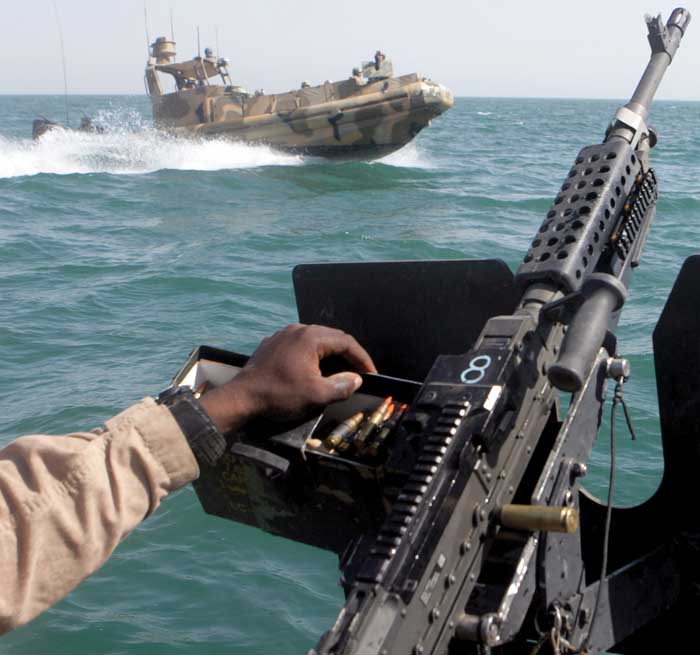
Their weapons are standard issue but there is little that is ordinary in their operational environment. While extreme temperatures, dust and precipitation are familiar foes to all combatants, Riverines face special challenges in maximizing the effectiveness of their guns while underway and during landside missions.
SAR talked at length with several experienced Riverines about these challenges. Their observations, we believe, will prove useful for a variety of warfighters on land, sea and in the air. This first installment in a two-part series affords a close look into specialized Riverine watercraft, the versatile array of crew-served weapons aboard and the dedicated Sailors who man the guns.
Fast Boats and Machine Guns
SAR’s first encounter with Detachment 1 of Riverine Squadron 3 came on the morning of April 2, 2009, at Mile Hammock Bay on Camp Lejeune Marine Corps Base, as they were preparing for another long training day. Heavy overcast, fog and driving rain emphasized the challenges of operating in all weather conditions but the hardy Riverines were eager to get underway for long-scheduled live fire maneuvers.
Lieutenant (Junior Grade) William F. Ashley, Det 1’s Officer in Charge, explained that Lejeune’s range safety requirements necessitated a careful visual reconnaissance to make sure no watercraft had strayed into the bay’s designated firing area. Unfortunately, the weather was so bad that Range Control’s small fixed wing aircraft couldn’t fly.
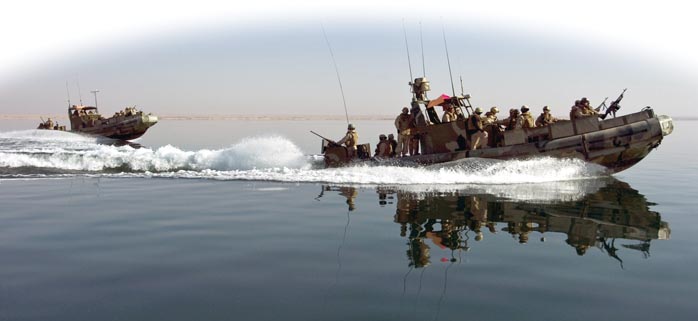
But waiting for a weather change that would allow range clearance afforded a good time for the requested interviews. We climbed up into the back of one of the unit’s heavily armored trucks to meet with two Riverines who had gamely volunteered for the task; Gunners Mate 1st Class (EXW/SW) Adam John Sanchez and Gunners Mate Chief (EXW/SW) Geovarrie “Geo” M. Lopez, both well seasoned Sailors.
The 29 year old Sanchez hails from Eagle River, Alaska, where he spent some time as a fishing guide. His ten years in the Navy included service on USS Spruance Guided Missile Destroyer before volunteering for Riverine two years ago. He soon deployed to Iraq with Det 1 and earned the Navy-Marine Corps Achievement Medal. He has been a Boat Captain for one year and his additional skills include Range Safety Officer and Crew Served Weapons Instructor.
Lopez, 35 years old, calls Key West, Florida, his hometown. He’s had a number of different assignments during seventeen years in the Navy, notably aboard the USS Gettysburg Guided Missile Cruiser. Volunteering for Riverine, he has two years with Det 1 and its Iraq deployment, earning the Navy-Marine Corps Achievement Medal. Lopez is a Boat Captain and a qualified Small Arms Instructor.
It worked well to interview them together because each one’s observations tended to bring additional insights from the other.
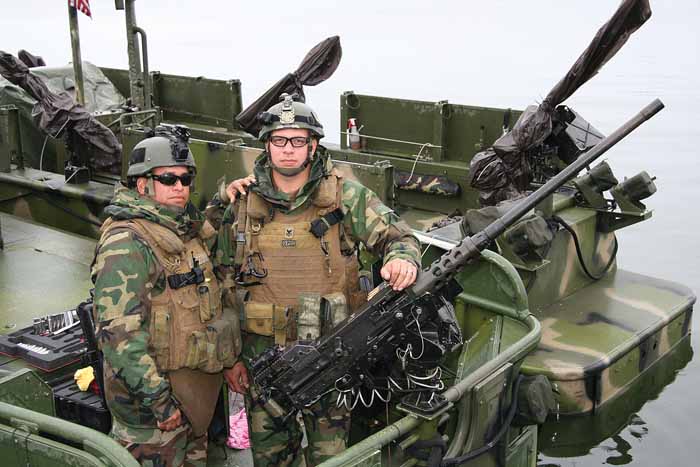
SAR: Why did you join the Navy and then transition to Riverine?
Sanchez: I considered a career in law enforcement and knew that Navy experience would be a good start. I have military in the family and they recommended the Navy. I asked for assignment to Riverine to ‘ramp up my career’ and get some combat experience.
Lopez: It was in my blood, my father’s also in the Navy. I’d seen my father’s experiences and wanted that part of my life as well. I went from the Army’s 82nd Airborne Division to Yeoman in Navy. I volunteered for Riverine, a job with action and combat experience.
SAR: Are you personally interested in firearms and shooting?
Sanchez: Oh yes, I’m a Gunners Mate (GM).
Lopez: I do like shooting, I love guns and it happens to be my job also as a GM.
SAR: What schools and training have prepared you for your current duties?
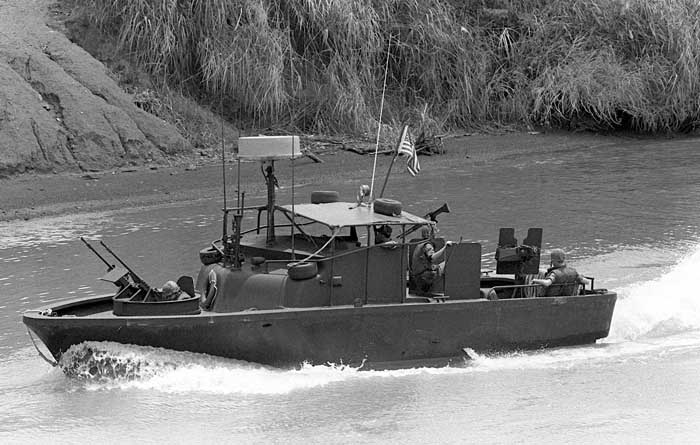
Sanchez: I have 0814 NEC (Navy Enlisted Code) for CSWI (Crew Served Weapons Instructor) through STS (Navy contractor Special Tactical Services), been through GM ‘A’ school (initial qualification) then ‘C’ school (advanced) as a Vertical Launch System Tech; also Marine Corps 0331 Machine Gunner Course. It’s outstanding training, intensive tests, very detailed. More landside shooting and then in RSO (Range Safety Officer) school we did more of the waterside shooting.
Lopez: GM ‘A’ school, 5 inch cannon, Small Arms Instructor school at Little Creek, landside shooting at Marine Corps 0331 Machine Gunner Course, and waterside starting here during this training cycle preparing for deployment.
SAR: Do you have the opportunity to train using computer simulators?
Lopez: No, we do actual training on the boats. Parked dry runs to get familiar with your stations so when you actually get on the water the only thing you have to get is your ‘sea legs’ to get your balance. No simulation, always reality with blanks then live ammo. We shoot underway against static targets.
Sanchez: Same training cycle. We all went through the 0331 Machine Gunner Course for the Marine Corps, helped a lot. They definitely pound in the information and that helps a lot. I had simulators in the 0814 CSWI school but as far as the rest of the unit, no. A couple others have had the CSWI course as well. STS did a good job in teaching, outstanding training, probably one of the better schools I’ve been to ever.
SAR: Is there enough time allocated for training?
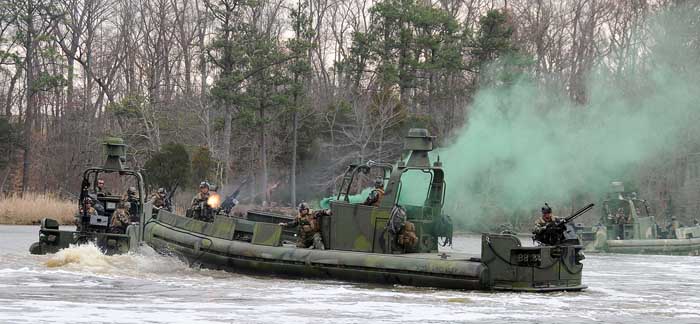
Sanchez: Yes, time has been OK but very condensed. The gunners are learning what they need to learn. Maybe expand the time a bit for a little more proficiency but overall it’s outstanding training.
Lopez: Definitely more training is always better. As of right now its doing the job and I know it’s getting people’s proficiency up on the weapons. New gunners on their first deployment are jumpin’ right in. I know I can rely on those guys on the guns to do their job.
SAR: Night shooting?
Sanchez: Absolutely, night operations are a major mission. NVGs (night vision goggles) PVS-14 monocular we’re using right now. PEQ-15 lasers mounted to each of the crew served weapons. Good gear even in fog and rain. The weather hasn’t been fantastic lately for training and we’ve been doing pretty good.
Lopez: Definitely what we need to be doing, most of our work is at nighttime. That’s really when you find out if the gunners are comfortable with what they’re doing. Anybody can do it in the daytime. The comfort zone for those gunners at nighttime changes when they have that night vision on and one of their eyes can’t see. They start shooting that gun and the flash wipes everything out. You find out their comfort levels and proficiency at nighttime.
SAR: What do you teach to compensate for that — close one eye?
Sanchez: Yeah, that’s one technique. Another is to move the NVG away from your face and look under it. It works because of the tracers once you’re on target. You use your laser to initiate the contact through NVGs and once you’re on target you can look underneath them (using tracers) and that works as well.
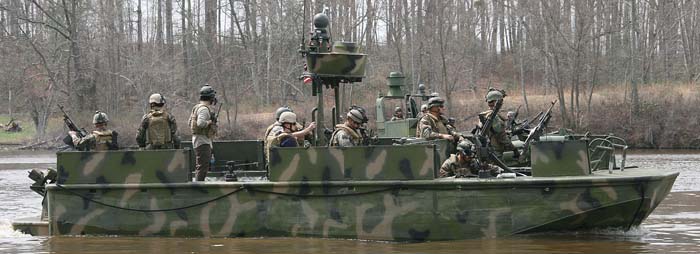
SAR: Do you use parachute flares for illumination?
Sanchez: We have the capability but tactically that’s not done. We’re lighting ourselves up enough with the muzzle flashes. We’re kind of in a unique situation because we have one way in and one way out on the river. There’s no sense in illuminating us any more than we need to.
SAR: What recommendations to the chain to improve operator skill with weapons?
Sanchez: It’s already being done. Riverine Group is constantly improving through critiques of training and operations. Our situation as RIVRON 3, we’re able to get the better training product because RIVRON 1 and 2 go through before us.
Lopez: Definitely, we have the best product that has been generated through the training cycle. And because we’re the first detachment in our squadron, we’re able to help the other two dets for their training cycle. Whatever we critique in our after action reports group can make some more improvements and it keeps on evolving and they get better training.
SAR: How about the Riverine Security Teams (RSTs)?
Sanchez: They’re in a different training pipeline; then we meet to do an interoperability where we all work together.
Lopez: Each Detachment has RSTs and their training is specific to the landside. They can’t do their mission without us and we can’t do our mission without them. They’re boat riders but they’re also trained as crew served weapon gunners. If one of our guys takes a hit they know what to do and can take over as well.
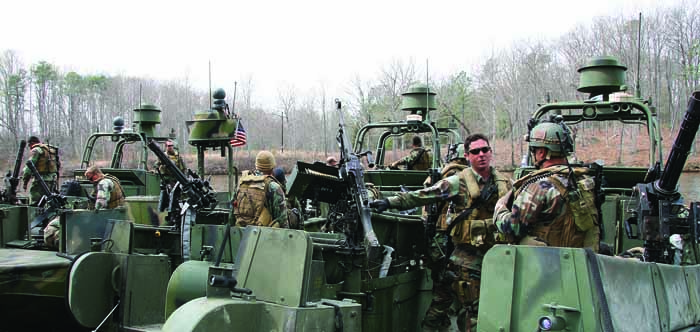
(Editor’s Note: Part 2 provides a detailed look at Detachment 1’s Riverine Security Team)
SAR: Your Detachment has three RPBs (Riverine Patrol Boats) with three weapon stations and one RAB (Riverine Assault Boat) with five weapon stations. Comment on each of the Crew Served Weapons on the boats, starting with the M240’s reliability and suitability for most missions.
Sanchez: If you take care of it, it will take care of you. It’s a great weapon you can be as surgical with it as you want with it depending on the proficiency of the gunner. Absolutely reliable.
Lopez: The 240 is very accurate and it’s like a workhorse. You can take it on shore when we have to provide security on ground for our RSTs so it serves two roles on the boat.
SAR: You have experience with the M60, how about a comparison?
Sanchez: The 60 is more of a land based assault weapon but the 240 is a better mounted 7.62mm machine gun.
Lopez: My experience with the M60, I mostly shot it off of ships and on a couple of ranges on shore. I like the 240 better, once I shoot it I’m on target and it’s surgical.
SAR: What needs improvement with the M240?
Sanchez: You’ve gotta take care of the gas regulators…when we’re firing it gets dirty very quickly.
SAR: And the .50 caliber M2HB?
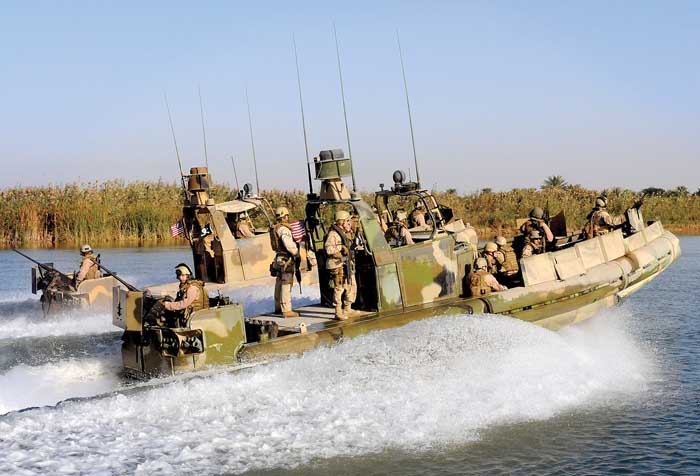
Sanchez: It’s been around forever for a reason. It’s a good gun if you need a hard target taken out, that’s why we have it on board. Longer range, heavier bullet, greater penetration. If you take care of it, it will take care of you. As long as you do those inspections, make sure none of those parts are worn too much – the normal inspection process – it’s a good gun as well.
Lopez: The amount of fifty caliber lead it puts down, it’s definitely something I would want on my boats at all times. Great against hard targets and when it goes off they know you got a fifty cal. – everybody can hear you out there.
SAR: Is headspace and timing tricky for the younger sailors?
Sanchez: With the training we’ve had its been pounded into their heads. We’ve never had any issues. Just part of settin’ up the gun.
Lopez: Just second nature so they get on their gun and know they have to do it.
SAR: Any recommendations for improvements to the M2HB? Maybe a quick-change barrel?
Sanchez: I’ve heard about it but it’s not needed. If you lay enough rounds downrange on target hopefully that target’s down before you need to do a barrel change.
Lopez: It’s been around so long that pretty much all the improvements have been already done on it. I’m happy with it personally; I don’t have any issues with it.
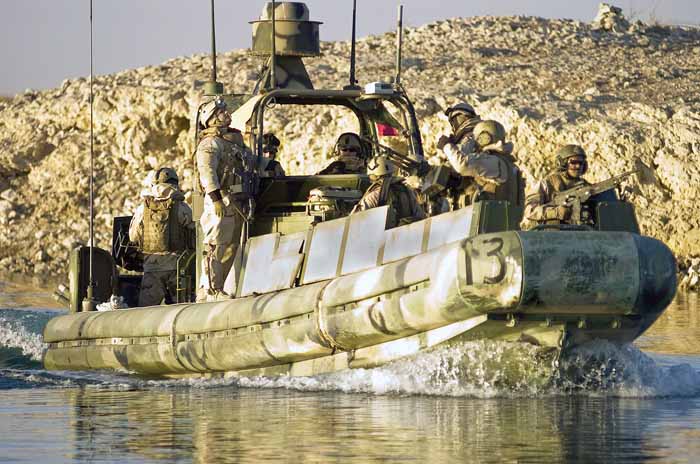
SAR: How about the 40mm Mark 19?
Sanchez: That’s a serious weapon as well. We’ve got the Mod 3 and it’s a good gun. We haven’t used it as much as we would have liked because the ammunition is a little hard to come by. But all the guys have the training needed to use the weapon properly. Some people are kinda skittish about it – it’s a very violent weapon – blowback operated with a very heavy bolt.
Lopez: I love that weapon. Ammo is harder to come by so shooting it – range time – is limited; but like all the other weapons, the guys have had training on it.
SAR: Is the MK 19 not usually mounted on the boats?
Lopez: We can take it out and it just depends on our missions, but 90% of the time we’ve got the 240 and fifty cal.
Sanchez: On our heavy mount (at the stern) we normally use the 50 cal. It’s more accurate and causes less collateral damage.
SAR: What would be the kind of mission you would need the MK 19 for?
Lopez: It depends on the threat assessment for the area of operations.
(The Detachment’s OIC has been silently observing the interview and now speaks up).
Ashley: Like the chief said, its mission dependent. If we were going to do a fire support mission we would take it out. Sometimes at least one of the four boats will have it mounted.
SAR: So your boats would be providing a kind of Naval Gunfire Support?
Ashley: I guess that’s one way of putting it. It all depends on what kind of environment we’re operating in. Unless it’s a “permissive environment” (few civilians, more open space) we tend to scale back on the MK19.
SAR: Tell us about the 7.62mm GAU-17 Minigun.
Sanchez: I’m a believer in it now. Originally not so much – probably because of lack of knowledge. Now that I’ve been through more training it’s definitely one of my favorite weapons.
Lopez: Some experience shooting it from ships but obviously totally different from this type of environment on boats. The only problems I had back then was with the batteries and battery chargers. Here we’re running them right off the electrical circuits (24 volt DC) on the boat. The weapon system itself is impressive – 3,000 rounds per minute. When you engage something or someone with that you’re gonna scare ‘em (smiles). Especially when you have four of them on board, one on each boat, going off at one time.
SAR: Have you been in a situation where you’ve needed that high volume of firepower?
Sanchez: I haven’t been in that situation but that’s what we’re training for right now. It’s one of those things that’s nice to have when you need it.
SAR: What needs improvement?
Lopez: Nothing at all. Very reliable.
Sanchez: The improvements have been made now that we’re using the Dillon Aero feeder-delinker. I guess there were some issues before but we personally haven’t had any. It shoots fine for us and we’ve put plenty of rounds through it.
SAR: What special maintenance needs to be done with them – particularly while operating in a semi-salt water environment?
Lopez: Nothing special at all, just more attention to detail. Not just with the GAU but all of our weapons. Constantly have to be on them cleaning, wiping, making sure when we squeeze that trigger we can get that end result.
SAR: How about ‘tricks of the trade,’ anything that’s not in the maintenance manuals?
Sanchez: We just use CLP (standard issue Cleaner Lubricant Preservative). It works.
Lopez: During deployment in sandy and dusty conditions just a thin coat of CLP. We try to keep it kind of dry. You don’t want too much. That sand builds up, cakes up on the weapon. Use just enough to keep it running. Obviously, when you’re out here in this kind of environment (heavy rain at Camp Lejeune) you’ll apply more CLP.
Sanchez: Probably when it’s raining, to constantly have dry rags on hand. But we bring that stuff out so I don’t have any issues. We keep everything the way it needs to be so it fires.
SAR: Any ‘wish list’ for accessories that you believe will improve the effectiveness of the detachment’s crew served weapons?
Sanchez: ‘Fifteens’ (AN/PVS-15) might be nice as far as NVGs (Night Vision Goggles). The dual viewfinders give better depth perception but we can still do the job fine with that we’ve got (PVS-14).
SAR: How about what’s mounted on the weapon itself? Like a Night Vision Sight?
Lopez: Once you start firing that scope wouldn’t work (because of muzzle flash). Our weapon mounted laser sight is good when used with NVGs.
SAR: In training do you use the 1-in-5 tracer to ball mix?
Lopez: For 7.62 yes, but not for .50 cal. We haven’t had any of that yet.
Sanchez: We adjust on impact.
SAR: How about different types of ammunition like .50 caliber APIT (Armor Piercing Incendiary Tracer)?
Lopez: For training, it’s just standard ball. The demand for APIT is greater in theater (Iraq).
SAR: Lieutenant, is there a problem getting .50 caliber tracer ammo?
Ashley: It would just be more about what the command (authorizes), what these guys get before they go on training operations. It hasn’t been an issue as far as getting it.
SAR: When you deploy in country is tracer and APIT available?
All: Yes.
SAR: The Coast Guard has some special 7.62mm short range ammunition for use in certain congested areas.
Ashley: There’s talk of us going to it because it opens up a lot of ranges that we could use. Right now it’s not in our allowance.
SAR: Any recommendations for changes to mounts? We talked about how the MK 19 really shakes that heavy weapon mount.
Sanchez: The MK 93 mount has buffers underneath the weapon that absorb a lot of it and the coxswains – the drivers of the boat – adjust however they need to while you’re firing the fifty or the MK 19 from the aft heavy weapon mount.
SAR: Both of those weapons (M2 and Mk 19) are recoil operated. Do you have to tweak the recoil buffer so that you don’t have cycling problems?
Lopez: We’ve never experienced that.
SAR: So the guys at NCWC Crane who developed the MK 93 mount must have gotten it right. How about the mounts for the 7.62mm guns?
Sanchez: They’re hard mounts with no recoil buffer. We haven’t had any issues at all with them. Also, all the mounts have adjustable traversing safety stops so you can’t shoot your own boat.
SAR: Would you recommend any changes to how the ammunition is carried on the mounts? Or add a rain shield or splash shield? Anything?
Sanchez: I’m happy with the way we’re running. I like it personally.
Lopez: It just depends on what mission you have and where you’re operating. Is it going to hamper you when you’re going to reload, what happens when the gun gets hot from shooting? It brings up more questions. Keep it simple.
SAR: What’s the next level of maintenance and repair for your weapons when they break down?
Lopez: We’re self-sufficient on a lot of things but we know when we have to send a weapon outside the command because we just can’t fabricate those parts. The knowledge they (specially trained armorers in the detachment) have keeps our weapons going.
SAR: But the turn-around time doesn’t leave you with an empty gun station?
Sanchez: No, we have plenty to fill in with. If we have to we can pull from another detachment but it’s not really an issue, ever.
SAR: Describe your most recent foreign deployment.
Sanchez: We did a seven month deployment (to Iraq) out of Lake Thar Thar and the Thar Thar River. Support missions for just about every unit out there. Inserting and extracting RSTs, sweeping villages and gathering intel. Stopping boats, looking for contraband, any illegal activities.
Ashley: We were focused a lot on ‘atmospheric collection,’ census type data to get a feel for who was operating on the water, living on the water, kind of the cultural aspects of it. Less intrusive and more to let the Iraqi people know we’re here to provide security. ‘Help us help you.’
SAR: Any firefights?
Sanchez: We were nearby a few of them but we didn’t actually have any direct support to those.
SAR: What lessons did you learn about yourself as a result of your deployment?
Sanchez: I can withstand mass amounts of heat (laughs). You’d think it was 200 degrees on some of those days.
Lopez: We weren’t really prepared for 120 degree plus heat but once we got there we knew what to do; hydration, how to take care of your body, hygiene. All those things that people take for granted when they’re stateside come into play when your resources are limited. With adequate training you can overcome anything. Then there’s patience, dealing with people, language barriers, plus you have to deal with civilians, the Iraqi Army and Police Forces. You have to have patience for that, taking your time in dealing with them.
SAR: How about your boatmates?
Sanchez: Same thing for them; I’m sure I can speak for them. They did an outstanding job over there. Got the job done.
SAR: Your body armor is heavy, hot and bulky and more so at 120 degrees. Do you wear it at all times on missions?
Sanchez: All the time. When you’re underway there’s a little bit of breeze (but) only when you’re moving and then it’s like a hair dryer blowin’ in your face.
SAR: Spend the night on the boats?
Lopez: When you go out on a mission and you get caught out there however long you stayed out there. We operated out in the field close to where our base was.
SAR: How cold does it get in the wintertime over there?
Lopez: Rainy and cold about like this (Camp Lejeune).
SAR: Where’s the next deployment?
Sanchez: They’re telling us anywhere at this point.
Ashley: Right now it’s up in the air. The way the rotation works there are successive squadrons in Iraq (1, 2 and 3). The mission in Iraq is ramping down so we could be possibly sent anywhere there are rivers.
SAR: Afghanistan have rivers?
Ashley: They do. I believe it’s one river that floods pretty regularly, with rapids and rocks (smiles). I’d be really surprised if they sent us up there
SAR: What advice do you have for Riverines, GMs in particular, preparing for their first deployment?
Lopez: Project what you need, supply-wise. We could be going somewhere way out of the supply system. Take what you think you’ll need and that way you’ll have a stockpile; oils, rags, cleaning materials, solvents. Everything you need for your weapons. Prepare yourself to an excess and you’ll be good to go.
SAR: How about mental preparation?
Sanchez: A pretty standard thing. In the military you do what you gotta do and get the job done.
SAR: Is there much turnover in personnel? How many new guys since last deployment?
Sanchez: We’ve got about three guys (laughs). They catch on fast and they’re caught up now. No issues, a very smooth process.
SAR: What’s the hardest thing for the younger sailors, the ones on their first deployment?
Lopez: I guess they get frustrated. Not having that contact with family.
Sanchez: I think they’ve got it good (laughs), real good.
Lopez: You take what you need. You can get ‘care packages’, stuff like that. You bring your snacks and basically take care of your own comforts.
SAR: How about the brotherhood of a boat crew, do you tend to stay together or do they mix and match?
Lopez: Initially that’s how it was but now we’re starting to operate by mixing the boat crews and I think that’s better. You get to know other people but the training is more standardized. That way it’s not ‘this is how my boat crew does it’ (but) there’s a standard format. For example if someone was gone, taken out, injured, I can take another person from another crew. He’s got to know exactly what to do. I know he can operate exactly like the previous member.
SAR: Help us understand this from an Army or Marine Corps perspective. If you’re in a combat arms unit it’s your squad, fire team, tank or gun crew. It’s going to be pretty much the same men the whole time.
Lopez: Yes, but people transfer, people get injured or go on leave. So you have to supplement your crew sometimes with other personnel. Also, now that we have the RAB (Riverine Assault Boat) in our detachment there are two more gunner stations. An RPB crew is generally five people but on the RAB you have five weapon stations so you have more people on that one boat crew. You have to supplement them from other boat crews. It’s generally a mixture of boat teams. Instances like that happen regularly.
SAR: But for the most part individual boat crews stay together?
Both: Yes.
Sanchez: We’ve already been on deployment with the majority of these guys – everybody’s pretty tight.
SAR: Have you had to throw anybody overboard?
Lopez: (laughs) No, not yet.
SAR: What would you like to say to young men about joining the Navy and why they should choose Riverine Forces? Fast boats and guns?
Sanchez: If you’re dedicated and you’ve got good motivation and you want to get into a combat environment I recommend Riverine to anybody who has all those three things.
Lopez: A young man coming into this environment fresh out of Boot Camp; it’s a totally different environment than ‘Big Blue Navy.’ You’re going to have to be – first thing – self sufficient, a lot of initiative, someone to rely on, dependable. This is a small unit, we do things by ourselves; we’re away from headquarters, away from ‘Big Navy.’ Wherever we’re deployed we’re always operating by ourselves.
SAR: What have we missed?
Lopez: You’ve covered it. The training is even better than when we initially started this command, the squadron. On the crew served weapons, everything. It’s evolving and I think it’s going in the right direction.
Coming Soon
Join the Riverines of Detachment 1 as they maneuver their boats in the tight confines of a brown water range, then lay down a torrent of suppressive fire to support a “hot extraction” of their Riverine Security Teams.
Find Out More:
Navy Expeditionary Combat Command: www.necc.navy.mil.
(SAR extends special thanks to Captain Anthony Krueger, Commander, Riverine Group One, and Lieutenant (JG) William Ashley, Officer-in-Charge of Detachment 1, Riverine Squadron Three, for giving us the opportunity to observe and report on the intensive weapons training being conducted in preparation for RIVRON THREE’s second operational deployment.)
| This article first appeared in Small Arms Review V13N6 (March 2010) |











